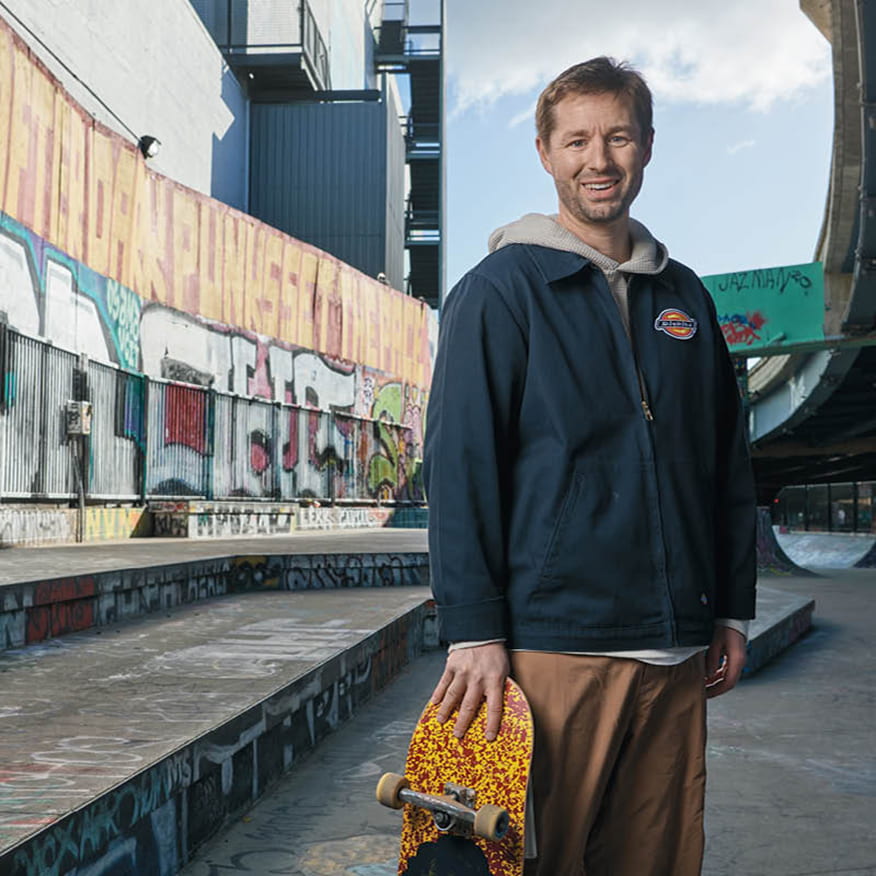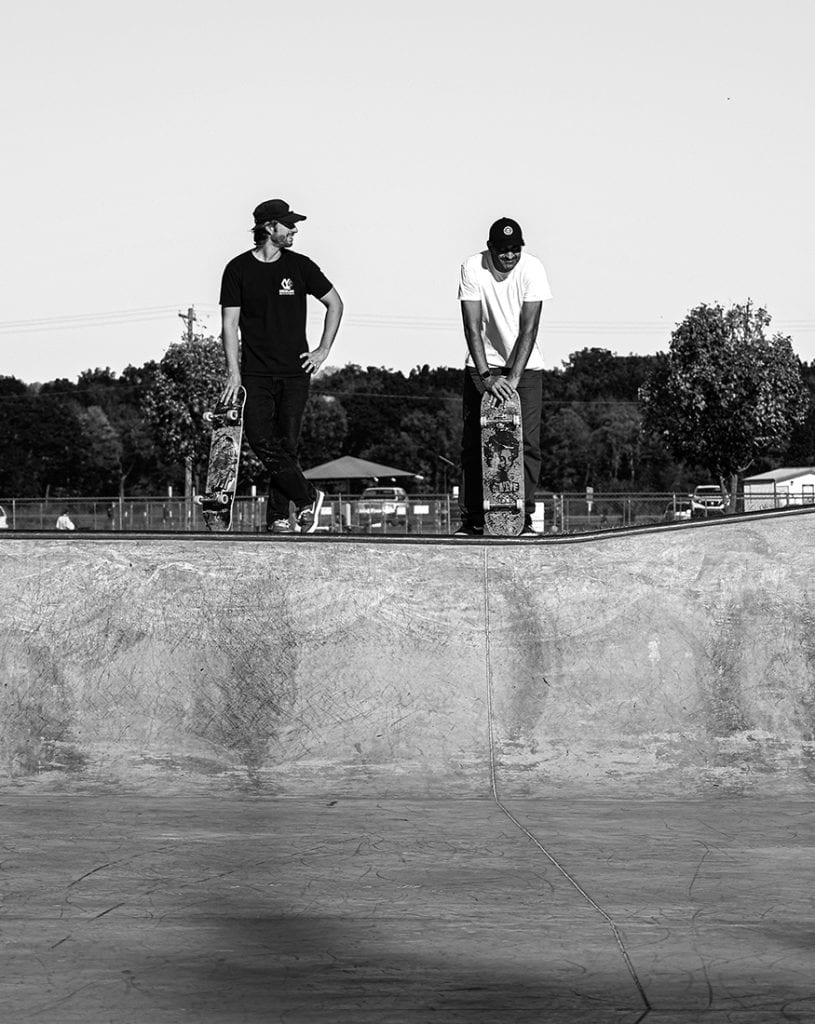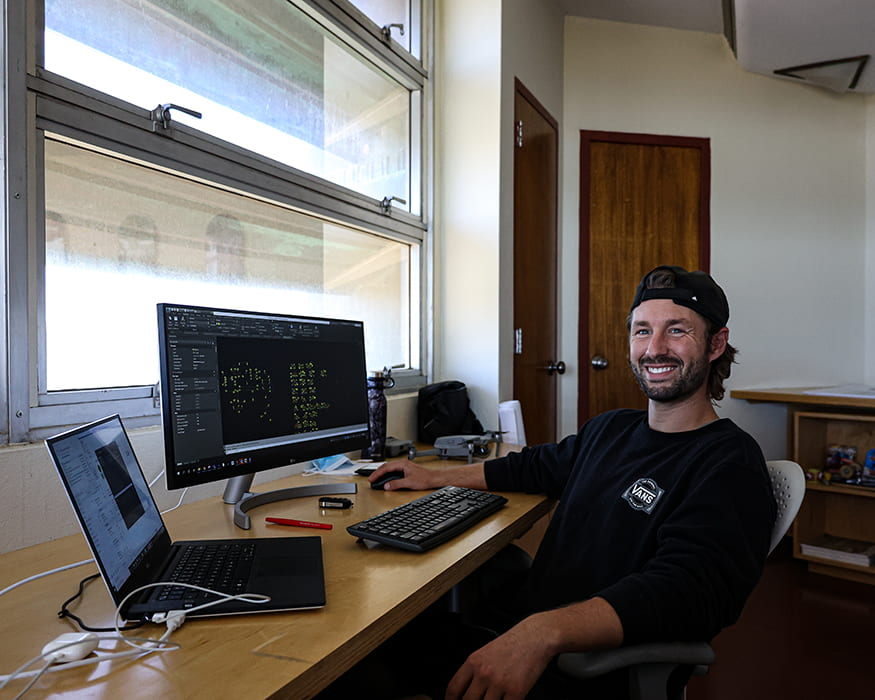Q&A: Get to Know President Grace Wang
WPI's 17th president reveals what attracted her to the position, what's surprised her so far, and how she relaxes.
Read StoryWhen Chris Long shows up at a skate park anywhere in the world, even though he might not know a single person there, he feels at home.
A sense of community knits skateboarders together—even if only for a fleeting hour—in a way that Long, a skate park designer with New Line Skateparks, finds both fascinating and comforting. “There are a lot of unlikely and unique connections made and discovered at a skate park,” he says. “It’s always refreshing to see groups of diverse individuals interacting and supporting each other.”
That tribal vibe played a big part in finding his current career path. About a year after earning his bachelor’s degree in civil engineering, Long, who is now based in San Francisco, attended the grand opening of the Lynch Family Skatepark in Boston and began casually chatting with folks nearby. At the time, he was doing civil engineering site work and roadway design and, while he appreciated the opportunities to gain real-world knowledge and essential job skills, he was steadily losing enthusiasm. “It was hard work and a good year, but I couldn’t see myself doing this forever,” he says.
The crowd of hundreds gathered around the bowls and berms of the new park that day included a huge skate community, some professional skaters, and Boston city staff members. Long heard someone nearby mention very specific measurements of a ramp design and found himself in a conversation with none other than the park’s designer.
When it comes down to it, an unsuccessful skate park is often the result of some very basic engineering and planning being overlooked.
“I gave him my number and said, ‘I am in civil engineering—please let me know if you ever need help.’” They kept in touch and the designer eventually helped Long identify the engineering skills that are increasingly in demand as more communities install professionally designed skate parks.
“When it comes down to it, an unsuccessful skate park is often the result of some very basic engineering and planning being overlooked,” he says.
The attention to detail in designing and building bowls, ledges, handrails, halfpipes, and ramps makes modern skate parks more artistic and sculptural community attractions, rather than the stereotype of a run-down, graffiti-covered area surrounded by torn chain-link fencing. The rebirth of the industry and the inherent design challenges inspire Long in his work at New Line, one of a handful of design and construction firms that specialize in concrete skate parks and pump tracks.
“Skate parks are no longer built from a napkin sketch,” he says. “The plans are fully engineered and quite detailed—just as much as any site or roadway project. I’m just so fascinated by it and the more I get to learn and study skateparks, the more I enjoy my work. A well-designed skate park can reshape a community and provide a creative, healthy outlet for all types of users. When designing a skate park facility, I try to leverage solutions that make all wheeled sports more accessible to more people.”
Long felt an initial sense that this career might be for him when he started at the company that designed the Boston skate park, where his work was split between traditional sports and skate parks in the New England region. When an opportunity came up with New Line, which only focuses on skate parks, it was a natural professional move and one he also considers a match of values. “It wasn’t just about skate parks,” he says. “The company cared about things I cared about—so much so that they let me work in a van and travel for a whole year.”
Long’s excitement for his work wasn’t anything he saw coming. “I was never 100 percent sold on civil engineering until I found skate park design,” he says, “and that was tough on me when I was in school. I wondered if I was doing all this work for a career I wasn’t sold on.” When Long began skating at Worcester’s Green Hill Park during his time at WPI, it was a necessary outlet from his school life. He never guessed what he liked to do in his spare time could be applied to an actual career. “In this role, skating is much more part of my life than it ever was.
As a trained engineer, moving into design pushed him far out of his comfort zone. “Design in general is tough,” says Long, whose official title is civil designer. “Whether it’s a skate park or a traditional project, the process can be a roller coaster of emotions but the result is rewarding—when everything falls into place, it all makes sense. Engineers in general want things to make sense. You analyze, you make conclusions—that makes sense. I don’t consider myself an artistic person by any means, so to find success in this realm is rewarding.”

Chris Long ’15
Long says finding his way in a more artistic area is heightened by the engineering knowledge he brings to a project. Whether he is conducting a site analysis, sketching a concept design, collaborating with community partners, working on grading and drainage calculations, or test riding a bowl during a construction site visit, his engineering sensibilities make design concepts work.
As with most plans, Long finds glitches. In a true exercise in putting theory into practice, he says, “sometimes I don’t fully understand how something functions until I ride it myself and watch others ride it with their own interpretation. This combination of theory and practice helps my designs continue to improve and evolve.”
Imperfections invisible to the eye become almost offensive as Long evaluates a skate park’s quality as it nears completion—or even at a park where he’s skating for relaxation. A skateboard’s small, hard wheels pick up every bump and dip—even those you can’t see, he explains. “I can hear it and feel it,” he says. “I’m more critical based on that and it makes me more passionate about getting it right.”
Understanding communities by talking with people who are invested in bringing a skate park in, or even those set on preventing it, is rewarding. “One of the best parts of our job is connecting with the community,” he says. “We ask them, ‘What’s important to you when you walk into the park?’ When we engage with a community and consider their input, the community develops a true sense of ownership for the project. They want a place for the whole community to enjoy.”
There’s so much more failure than success at a skate park, but people keep getting up.
Some want to highlight regional distinctions, such as colors or patterns or features that mimic public places where they like to skate but are typically not allowed. Safety is important, so having parks with high visibility, adjacent to other spaces and with areas to sit and to park, and with restrooms nearby is often paramount.
Skate parks offer something intangible as well. “There’s so much resilience,” he says. “There’s so much more failure than success at a skate park, but people keep getting up. Many use skateboarding as an outlet, like I did during my time at WPI. Making that resource more available to all demographics—even underprivileged demographics—is important to me.”
In the end, after all the design is done, all the concrete has been poured, and adjustments have been made, Long’s pure delight at seeing people enjoy the parks he’s had a hand in designing is evident. It’s rare to be able to create something long-lasting that the public is able to interact with on a deep and personal level. “When I see a quality skate park being fully utilized and enjoyed by a community,” he says, “well, that’s the icing on the cake.”




Long took a leap into the unknown during the COVID-19 pandemic and scrapped typical work and life expectations to travel around the country in his van. With no rent and no particular living-space anchor for the first time, he says the added flexibility gave him a chance to blend exploration with work.
Traveling from one skate park to another for New Line, he’d set up his “mobile office” (a small chair and desk behind the front passenger seat) and arrive at each new site to assess the custom work, including everything from the feel of the concrete (smooth but not slippery) to the exacting measurements of rails or trick areas (the expected height at the jumping-off point has to align with the length and drop for safety).
Comparing the paper plans with the physical construction is a detail-oriented exercise, he says. “I would take a look and say, ‘Yes, that’s what we mean with the design.’ It comes down to how the designers thought it would all work on paper and how the construction team interpreted how it would work from what was in the plans.” Sometimes it matches, sometimes it has to be fixed.